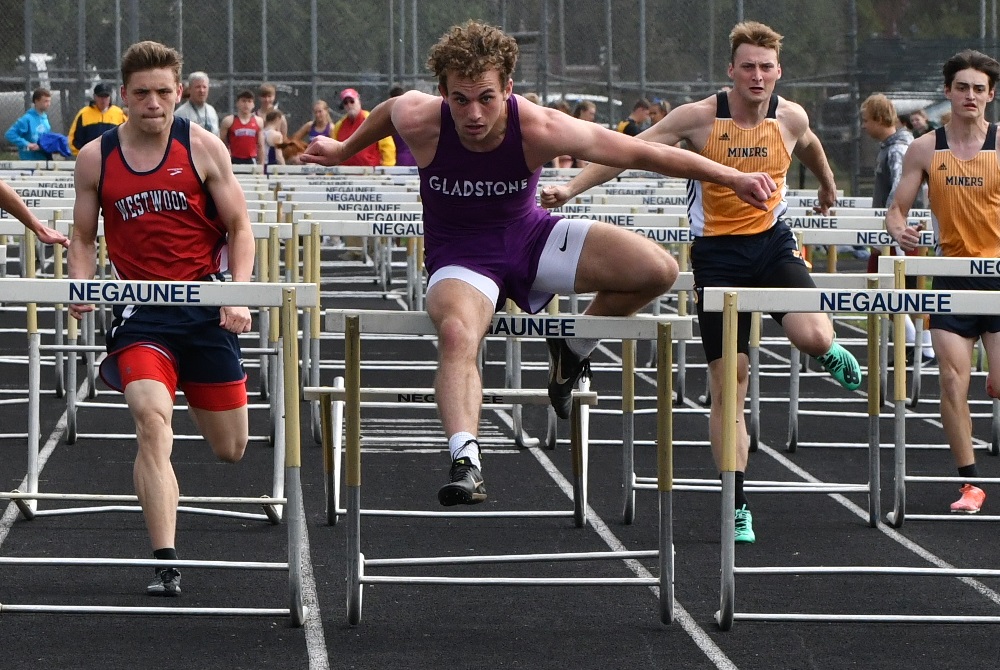
Preview: Past Champs Return to UP Boys Track & Field Finals
By
Geoff Kimmerly
MHSAA.com senior editor
June 4, 2021
Nearly two calendar years have passed the last Upper Peninsula Boys Track & Field Finals.
But three past individual champions will return Saturday with opportunities to add to career achievements first built up before COVID-19 led to the cancelation of last season.
Gladstone’s Blake Servant and Calvin Thibault and Gwinn’s David Duvall all have won at least one Finals title and will be among those to watch as all three divisions again will be competed at Kingsford High School.
Events begin at 10 a.m. (EDT) and tickets to attend can be purchased online only at GoFan. The meets also will be broadcast on MHSAA.tv and viewable with subscription.
Below is a glance at team contenders and individuals to watch in all three divisions.
Division 1
Top Regional scores: Marquette 71, Houghton 70, Gladstone 60.
Team forecast: Gladstone is the reigning champion after a 2019 run where it broke Marquette’s previous four-year hold on the Division 1 title. But Marquette may be the team to chase again with top seeds in two relays, four individual races and shot put. Houghton was runner-up in 2018 and 2016 and is seeking its first championship since 1992. The Gremlins got three individual championships and a leg of a relay winner from junior Eric Weiss at their Regional, and he could be important stacking up in the distance races. Gladstone’s star hurdlers also should factor into the team title mix.
Derek Douglas, Escanaba: The now-senior was fourth in the 800 and ran on three relays at the 2019 Final, and at this year’s Regional he won the 800 (2:01.73) by more than a second and was second in the 400.
Brady Schultz, Menominee: The Maroons junior high-jumped 6-foot-6 at his Regional to win by two inches, and a repeat of that jump would set the UPD1 Finals record by an inch.
Blake Servant, Gladstone: The discus champion as a sophomore in 2019, he may be in line for much more after outpacing two-time reigning Finals champ and teammate Calvin Thibault (see below) in the 110 (15.98) and 300 hurdles (41.9) at the Regional in addition to winning discus (136-9) and long jump (20-8).
Calvin Thibault, Gladstone: Now a senior, Thibault won the 110 and 300 hurdles Finals championships as both a freshman and sophomore, and in addition to Regional runner-up finishes in those races two weeks ago also took third in the 200 and fourth in the 100.
Carson & Colin Vanderschaaf, Marquette: After finishing third and fifth, respectively, in UPD1 cross country in the fall, Marquette’s sophomore distance standouts could be climbing the podium. Carson has the fastest seed times in the 3,200 (10:14.24) and as part of the 3,200 relay (8:45.36). Colin also runs on that 3,200 relay and is seeded first in the 1,600 (4:38.98).
Division 2
Top Regional scores: Iron Mountain 63, Norway 53½, Ishpeming 39.
Team forecast: Ishpeming won back-to-back team championships in 2018 and 2019 and has earned five over the last six seasons, but that streak could be coming to an end as Iron Mountain seeks its first title since 2000 and Norway its first since 2005. Norway could be in line for some big points with the top seeds in two field events, two relays and two individual races. Iron Mountain, however, has an advantage on depth with all four relays and 17 individual entries competing. Ishpeming is right behind with all four relays and 14 individual entries.
Silas Broberg, Ishpeming: The Division 2 cross country champion in the fall will attempt to cap his high school career with another title or more, entering as the top seed in the 3,200 (11:23.9) by 18 seconds while also running the 800, 1,600 and on the 3,200 relay.
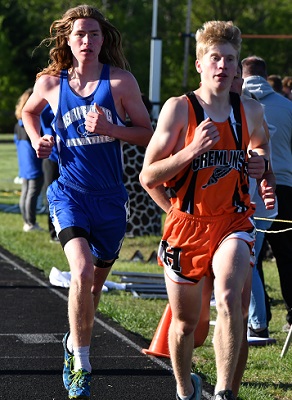 Adam Cavagnetto, Norway: The junior distance standout enters the weekend as the top-seeded contender in both the 800 (2:10.85) and 1,600 (4:46.47).
Adam Cavagnetto, Norway: The junior distance standout enters the weekend as the top-seeded contender in both the 800 (2:10.85) and 1,600 (4:46.47).
David Duvall, Gwinn: He was one of the most impressive performers as a sophomore in 2019, winning the 110 hurdles and finishing runner-up in the 300 and long jump. He’ll be a contender in those three events and as part of the 400 relay, with his 18.16 seed time in the 110 pacing the field.
Christian Koiveniemi, St. Ignace: After running two Finals relays as a freshman in 2019, he’s back as a junior with the top seeds in the 100 (12.08) and 200 (24.77) and also the high jump (5-6).
Landon Sudelius, West Iron County: He took sixth in both hurdles races two years ago as a freshman, but enters this weekend seeded first in the 300 (45.36) and second in the 110.
Division 3
Top Regional scores: Pickford 73, Stephenson 65, Rapid River 64.
Team forecast: Rapid River has had the most recent success of the teams listed above, with two titles and two runner-up finishes between 2015-18 and a fourth place in 2019. Dominant field events would be the Rockets’ ticket this time, while Pickford has some likely high scorers throughout the lineup. Stephenson could be in line for its first team title since 2007 with 23 individual entries and all four relays running including two that are top-seeded. Powers North Central finished only three points behind Stephenson at their Regional and also has some interesting high-scoring possibilities.
Cameron Hoornstra, Brimley: After running the 800 and 1,600 two years ago as a sophomore, Hoornstra has found his stride in the sprints and enters this weekend with the top seed in the 100 (12.0) and fourth in the 200, and he’ll also run the 400 and is fourth-seeded in the long jump.
Kolson Kytta, Chassell: The Division 3 cross country runner-up in the fall could end his Chassell career as a champion entering this weekend with the top seeds in the 1,600 (4:39.17) and 3,200 (10:36.52).
Conner LeClaire, Dollar Bay: He got on the board with a fifth-place finish in the 300 hurdles in 2019 and returns as a senior with the top seed time in that race (43.85) and third-fastest in the 110.
Ben & Max Lenaker, Rapid River: The senior twins both are top seeds in field events, with Ben’s 20-9 pacing long jump and Max’s 6-0 tops in high jump. Ben also is top-seeded in the 400 (52.80) by more than a second.
PHOTOS: (Top) Gladstone's Blake Servant earns one of his four championships during the Mid-Peninsula Conference meet May 24 in Negaunee. (Middle) Houghton's Eric Weiss wins the 3,200 at the Mid-Peninsula finals with Ishpeming's Silas Broberg taking second. (Photos by Cara Kamps.)
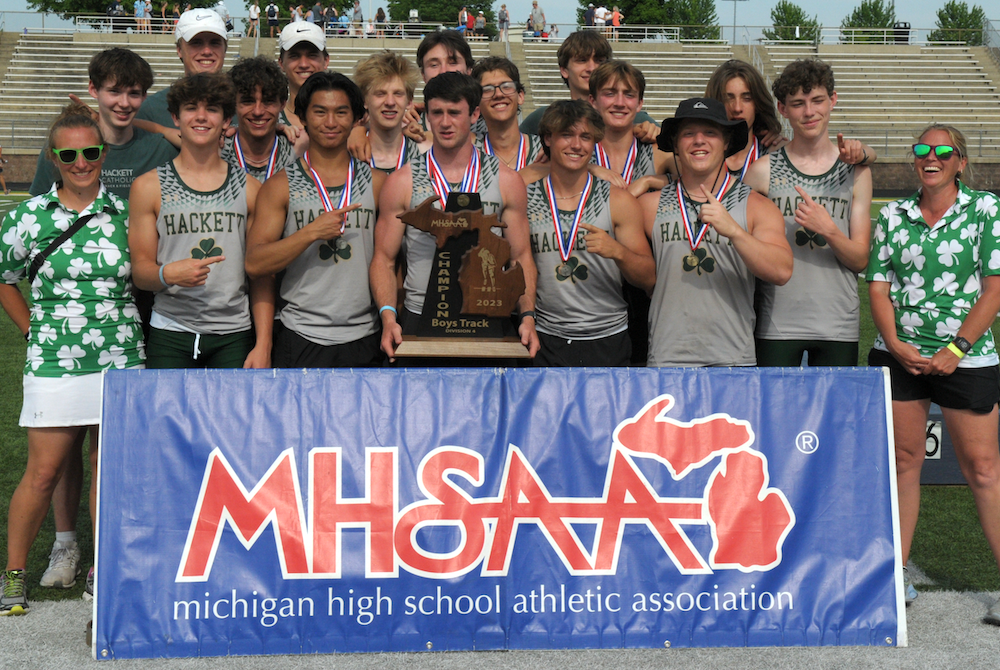
Thrower Claims Lone Individual Title to Lead Hackett to Team 3-Peat
By
Tom Lang
Special for MHSAA.com
June 3, 2023
Kalamazoo Hackett Catholic Prep just keeps winning and winning.
This time the Irish took home their fourth title in the last five Lower Peninsula Division 4 Track & Field Finals, on Saturday at Hudsonville.
Hackett’s only individual title was taken by discus winner Nathan Buchmann, a senior, who was fine knowing he was the shortest in stature among all the sizable competitors.
“In the offseason after football I worked out every day, working towards this goal,” he said after getting his medal. “I would say this takes 80 percent technique and 20 percent strength to throw the discus. So, length can help but if you have good technique and are really strong, that will play into it.
“I think we are very balanced throughout the meet today,” he said about teammates that scored points in finishes other than first place. “We have 13 guys here today, and we have people in a lot of the races. But I do not run; I have too short of legs to be a fast runner,” he said with a chuckle.
Buchmann had to work through a hip injury to compete this spring.
“I think the setbacks are what make you strong,” he said. “You can either give up through the setbacks or push forward and become better.”
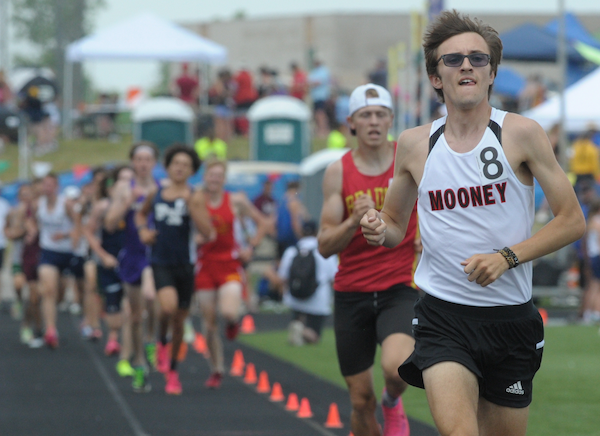 Coach Charissa Dean agreed.
Coach Charissa Dean agreed.
“The kids have big hearts,” she said after all the points were totaled and the Irish were on top once again, with 53. “They worked hard. They had a lot of potential when we started the season. And we had a lot of drive to put in the work, and we are happy the results came out the way they did.”
Reading was runner-up at 47 points, followed by Wyoming Potter’s House Christian with 42, then Fowler and Flint Beecher each with 37 points.
Senior Lezawe “Moses” Osterink, of Potter’s House Christian, placed second in 1,600 but took the 3,200 title as defending champ of both. He dominated the latter by lapping the field with a final lap kick that resembled more of a superhero speedster.
“Nobody really took it out that hard at the start,” he said. “There was a freshman (Marek Butkiewicz of Hackett) that tried to get the pace going quick, but me and Dakota (Dykhuis of Montabella) just kind of sat back and gradually pulled him through.
“We took it gradually, and I was just relying that I could kick.”
Kick did he ever. The trio were neck and neck the majority of the race in a grouping ahead of the pack.
“With 400 to go I just tried to go all out,” Osterink said. “I had a lot more left than I thought and I was pleased with the win. Not really the time, but that doesn’t matter, especially this hot out.”
The overall meet was in the low 90s/high 80s heat and searing sun all day. So, race officials allowed the unique opportunity for coaches to spray the runners with water and give them water bottles.
“It was very weird because I’ve never taken water to drink while I’m running, so I didn’t know how that would feel,” Osterink said. “And they were spraying us and hitting us in the face. It was kind of fun.”
Junior Tyler Lenn of Marine City Cardinal Mooney defeated Osterink at his own game in the 1,600.
“I’m feeling great,” Lenn said after grabbing the medal. “I said to a newspaper after one of my races (during the season) I was right where I wanted to be. This has been a long rebuilding process for me since an injury back in the fall, and I set a pretty high goal the day the injury happened. I was telling myself I needed to fulfill what I said I would do at the beginning of last cross country season. And that is what I did today.”
Lenn suffered an ankle sprain from a misstep that turned worse because he kept running through the season on it.
“Coming back from that was pretty tough, but I wouldn’t have it any other way,” he said. 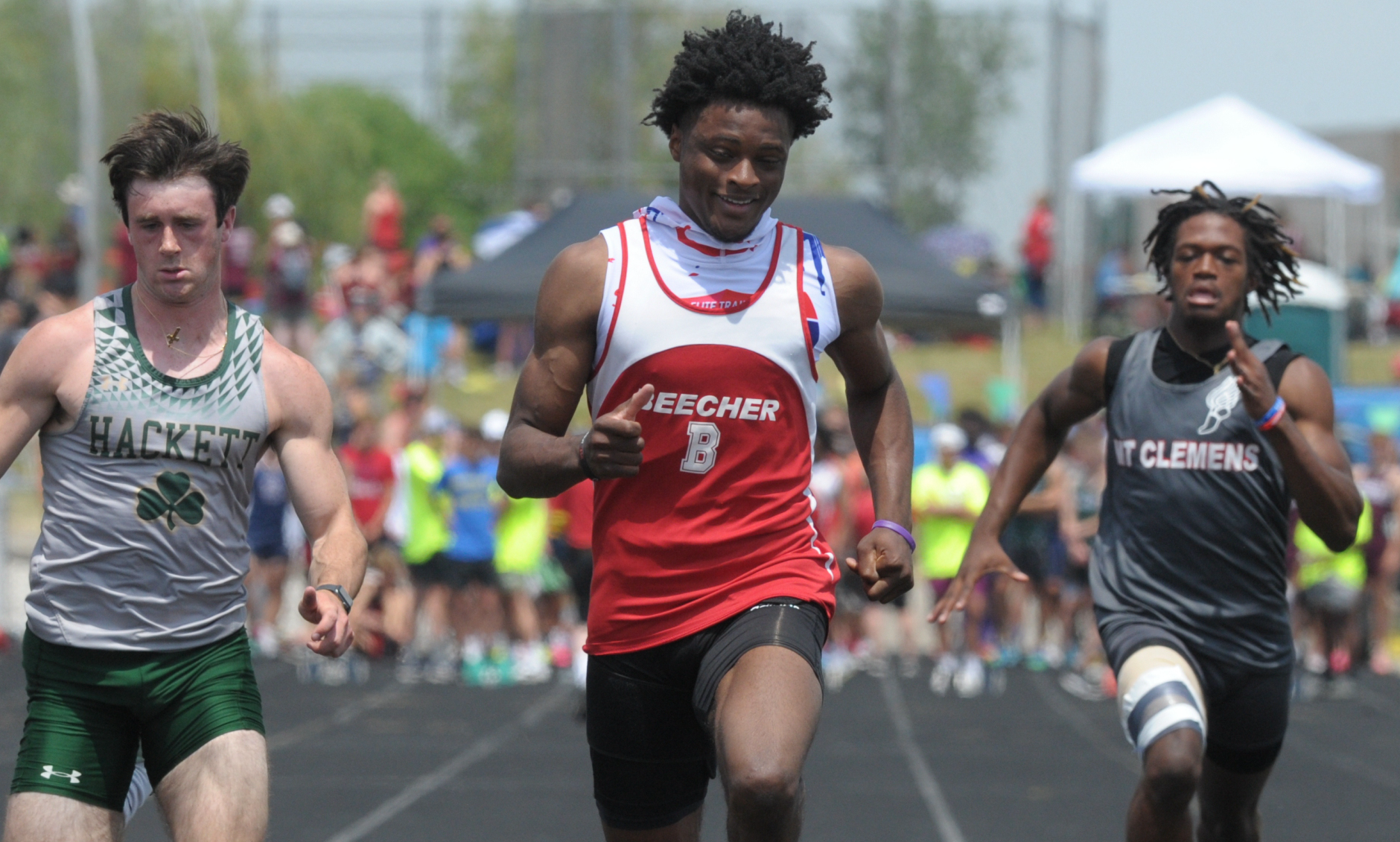 “Perseverance; I said from the beginning what I was going to do. I kept my eye on that target, and no matter the circumstances life threw at me, that I was going to make it happen and I am a man of my word.”
“Perseverance; I said from the beginning what I was going to do. I kept my eye on that target, and no matter the circumstances life threw at me, that I was going to make it happen and I am a man of my word.”
Jaylin Townsend, a senior from Flint Beecher, dominated the short races. He won the 100 dash (10.67) and 200 dash at 22 seconds flat. It was his third 100 win at a Finals.
“I put in a lot of work; I had to three-peat,” he said after the 100. “There’s a lot of great competition here, so I knew I had to come out and run my best.”
Concord in the 400 (43.72), Buckley in the 800 (1:30.76) and 1,600 (3:29.13) and Potter’s House in the 3,200 (8:14.18) were relay champs Saturday. Reading’s Tayshawn Bester won the 110 hurdles (15.13), and Athens’ Landen Bennett won the 300 (39.85). Caseville’s Nathan Feltner won the 400 (50.76), and Vestaburg’s Owen Patton claimed the 800 (1:55.11).
Fruitport Calvary Christian’s Bradley Richards won the high jump (6-10), and Peck’s Alex Affer won the long jump (23-4). McBain Northern Michigan Christian’s Isaac Bowden was first in pole vault (13-0), and Brown City’s Kyle Affer won shot put (49-2).
PHOTOS (Top) Kalamazoo Hackett Catholic Prep celebrates its third-straight LPD4 title Saturday. (Middle) Cardinal Mooney's Tyler Lenn, far right, sets the pace in the 1,600. (Below) Flint Beecher's Jaylin Townsend, middle, crosses the finish first for one of his two sprint championships. (Photos by Ken Swart/RunMichigan.com.)

